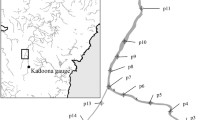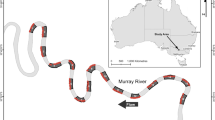Abstract
Demographic data provide a basis for understanding the life history and ecology of species, factors which are vital for informing conservation efforts; however, little is known regarding the population ecology of most snake species, including the threatened Eastern Indigo Snake (Drymarchon couperi). We used 11 years (1999–2009) of capture-mark-recapture (CMR) and 2.5 years (2003–2005) of radiotelemetry data from southeastern Georgia, USA, in a CMR modeling framework to estimate apparent survival, capture and transition probabilities, and evaluate factors influencing these parameters. The model-averaged estimate of overall apparent annual survival probability was 0.700 (±0.030 SE) and is comparable to that obtained from known fate analysis (radiotelemetry) at the same site. Body size positively influenced survival, regardless of sex. Capture probability differed seasonally by sex, suggesting lower capture probability for females in fall and males in winter. There was no evidence for effect of precipitation or site-specific differences in survival. Model averaged estimate of annual adult survival estimated using multistate CMR models was 0.738 ± 0.030 and 0.515 ± 0.189 for subadults. We estimated population growth rate (λ) and elasticity (proportional sensitivity) of λ to vital rates using a stage-structured matrix population model. Population growth rate ranged from 0.96 to 1.03 depending on the value of the probability of transitioning from subadult to adult stage. The λ was proportionally most sensitive to changes in adult survival rate, followed by subadult survival. Our results suggest that protecting adult snakes and their habitats would result in the highest likelihood of long-term population stability and growth.





Similar content being viewed by others
References
Akaike H (1973) Information theory and an extension of the maximum likelihood principle. In: Petrov BN, Csaki F (eds) Second International Symposium of Information Theory. Akademiai Kiado, Budapest, pp 267–281
Altwegg R, Dummermuth S, Anholt BR, Flatt T (2005) Winter weather affects asp viper Vipera aspis population dynamics through susceptible juveniles. Oikos 110:55–66
Blouin-Demers G, Prior KA, Weatherhead PJ (2002) Comparative demography of black rat snakes (Elaphe obsoleta) in Ontario and Maryland. J Zool 256:1–10
Bonnet X, Guy N, Shine R (1999) The dangers of leaving home: dispersal and mortality in snakes. Biol Conserv 89:39–50
Bowler KJ (1977) Longevity of reptiles and amphibians in North American collections. Herpetological Circular 6. Society for the Study of Amphibians and Reptiles, Lawrence
Breininger DR, Legare ML, Smith RB (2004) Eastern Indigo Snakes (Drymarchon couperi) in Florida. In: Akcakaya HR, Burgman MA, Kindvall O, Wood C, Sjogren-Gulve P, Hatfield J, McCarthy M (eds) Species conservation and management: case studies. Oxford University Press, New York, pp 299–311
Brownie C, Hines JE, Nichols JD, Pollock KH, Hestbeck JB (1993) Capture-recapture studies for multiple strata including non-Markovian transitions. Biometrics 49:1173–1187
Burnham KP, Anderson DR (2002) Model selection and multimodel inference: a practical information-theoretical approach, 2nd edn. Springer, New York
Caswell H (2001) Matrix population models: construction, analysis, and interpretation. Sinauer Associates, Sunderland
Conant JR, Collins JT (1998) A field guide to reptiles and amphibians: eastern and central North America. Houghton Mifflin Company, Boston
Cormack RM (1964) Estimates of survival from the sighting of marked animals. Biometrika 51:429–438
de Kroon HJ, van Groenendael J, Ehrlén J (2000) Elasticities: a review of methods and model limitations. Ecology 81:607–618
Diemer JE, Speake DW (1983) The distribution of the eastern indigo snake, Drymarchon corais couperi, in Georgia. J Herpetol 17:256–264
Dodd CK Jr (1987) Status, conservation, and management. In: Seigel RA, Collins JT, Novak SS (eds) Snakes: ecology and evolutionary biology. MacMillan, New York, pp 478–513
Dodd CK Jr (1993) Strategies for snake conservation. In: Seigel RA, Collins JT (eds) Snakes: ecology and behavior. McGraw-Hill, Inc., New York, pp 363–393
Dodd CK Jr, Barichivich WJ (2007) Movements of large snakes (Drymarchon, Masticophis) in north-central Florida. Fla Sci 70:83–94
Fahrig L (2001) How much habitat is enough? Biol Conserv 100:65–74
Fitch HS (1987) Collecting and life-history techniques. In: Seigel RA, Collins JT, Novak SS (eds) Snakes: ecology and evolutionary biology. MacMillan, New York, pp 143–164
Fitch HS (1999) A Kansas snake community: composition and changes over 50 Years. Krieger, Malabar
Forsman A (1993) Survival in relation to body size and growth rates in the adder, Vipera berus. J Anim Ecol 62:647–655
Frost C (2006) History and future of the longleaf pine ecosystem. In: Jose S, Jokela EJ, Miller DL (eds) The longleaf pine ecosystem: ecology, silviculture, and restoration. Springer, New York, pp 9–42
Godley JS (1980) Foraging ecology of the striped swamp snake, Regina alleni, in southern Florida. Ecol Monogr 50:411–436
Groves F (1960) The eggs and young of Drymarchon corais couperi. Copeia 1960:51–53
Hyslop NL (2007) Movements, habitat use, and survival of the threatened Eastern Indigo Snake (Drymarchon couperi) in Georgia. PhD dissertation, The University of Georgia, Athens, p 132
Hyslop NL, Cooper RJ, Meyers JM (2009a) Seasonal shifts in shelter and microhabitat use of the threatened Eastern Indigo Snake (Drymarchon couperi) in Georgia. Copeia 2009:460–466
Hyslop NL, Meyers JM, Cooper RJ, Stevenson DJ (2009b) Indigo Snake capture methods: effectiveness of two survey techniques for Drymarchon couperi in Georgia. Fla Sci 72:93–100
Hyslop NL, Meyers JM, Cooper RJ, Norton TM (2009c) Survival of radio-implanted Eastern Indigo Snakes (Drymarchon couperi) in relation to body size and sex. Herpetologica 65:199–206
Jayne BC, Bennett AF (1990) Selection on locomotor performance capacity in a natural population of garter snakes. Evolution 44:1204–1229
Jolly GM (1965) Explicit estimates from capture-recapture data with both death and immigration-stochastic model. Biometrika 52:225–247
Laake JL, Rexstad E (2007) RMark—an alternative approach to building linear models. Appendix C. In: Cooch EG, White GC (eds) Program MARK: a gentle introduction. http://www.phidot.org/software/mark/docs/book/
Landers JL, Speake DW (1980) Management needs of sandhill reptiles in southern Georgia. Proc Annu Conf Southeast Assoc Fish Wildl Agencies 34:515–529
Landers JL, Van Lear DH, Boyer WD (1995) The longleaf pine forests of the Southeast: requiem or renaissance. J For 93:39–44
Layne JN, Steiner TM (1996) Eastern indigo snake (Drymarchon corais couperi): summary of research conducted on Archbold Biological Station. US Fish and Wildlife Service, Jackson
Moler PE (1985) Home range and seasonal activity of the eastern indigo snake, Drymarchon corais couperi, in northern Florida. Final performance report. Study E-1-06, III-A-5. Florida Game and Fresh Water Fish Commission, Tallahassee
Moulis RA (1976) Autecology of the eastern indigo snake Drymarchon corais couperi. Bull NY Herpetol Soc 12:14–23
Nichols JD, Kendall WL (1995) The use of multi-state capture-recapture models to address questions in evolutionary ecology. J Appl Stat 22:835–846
O’Brien S, Robert B, Tiandry H (2005) Consequences of violating the recapture duration assumption of mark-recapture models: a test using simulated and empirical data from an endangered tortoise population. J Appl Ecol 42:1096–1104
O’Connor PF (1991) Captive propagation and post-copulatory plugs of the eastern indigo snake, Drymarchon corais couperi. Vivarium 3:32–35
Oli MK, Dobson FS (2003) The relative importance of life-history variables to population growth rate in mammals: Cole’s prediction revisited. Am Nat 161:422–440
Parker WS, Plummer MV (1987) Population ecology. In: Seigel RA, Collins JT, Novak SS (eds) Snakes: ecology and evolutionary biology. MacMillan, New York, pp 253–301
Rhodes JR, Callaghan JG, McAlpine CA, de Jong C, Bowen ME, Mitchell DL, Lunney D, Possingham HP (2008) Regional variation in habitat-occupancy thresholds: a warning for conservation planning. J Appl Ecol 45:549–557
Seber GAF (1965) A note on multiple-recapture census. Biometrika 52:249–259
Shine R, Bonnet X (2009) Reproductive biology, population viability and options for field management. In: Mullin SJ, Seigel RA (eds) Snakes: ecology and conservation. Cornell University Press, Ithaca, pp 172–200
Smith CR (1987) Ecology of juvenile and gravid eastern indigo snakes in north Florida. MS thesis, Auburn University, Auburn, p 129
Speake DW, McGlincy JA (1981) Response of eastern indigo snakes to gassing their dens. Proc Annu Conf Southeast Assoc Fish Wildl Agencies 35:135–138
Speake DW, McGlincy JA, Colvin TR (1978) Ecology and management of the eastern indigo snake in Georgia: a progress report. In: Odum RR, Landers JL (eds) Rare and endangered wildlife symposium. Georgia Department of Natural Resources, Game and Fish Division Technical Bulletin WL 4. Social Circle, Georgia, pp 64–73
Speake DW, McGlincy JA, Smith C (1987) Captive breeding and experimental reintroduction of the eastern indigo snake. In: Odum RR, Riddleberger K, Ozier J (eds) Third southeast nongame and endangered wildlife symposium. Georgia Department of Natural Resources, Game and Fish Division, pp 84–88
Stahl JT, Oli MK (2006) Relative importance of avian life-history variables to population growth rate. Ecol Model 198:23–39
Stanford KM, King RB (2004) Growth, survival, and reproduction in a northern Illinois population of the Plains Gartersnake, Thamnophis radix. Copeia 2004:465–478
Steiner TM, Bass OL Jr, Kushlan JA (1983) Status of the eastern indigo snake in southern Florida National Parks and vicinity. South Florida research center report SFRC-83/01. Everglades National Park, Homestead
Stevenson DJ (2006) Distribution and status of the eastern indigo snake (Drymarchon couperi) in Georgia: 2006. Unpublished report to the Georgia Department of Natural Resources Nongame and Endangered Wildlife Program, Forsyth, pp 10 and appendices
Stevenson DJ, Hyslop NL (2010) Drymarchon couperi (Eastern Indigo Snake). Long-distance interpopulation movement. Herpetol Rev 41:91–92
Stevenson DJ, Dyer KJ, Willis-Stevenson BA (2003) Survey and monitoring of the Eastern Indigo Snake in Georgia. Southeast Nat 2:393–408
Stevenson DJ, Enge KM, Carlile L, Dyer KJ, Norton TM, Hyslop NL, Kiltie RA (2009) An Eastern Indigo Snake (Drymarchon couperi) mark-recapture study in southeastern Georgia. Herpetol Conserv Biol 4:30–42
Stevenson DJ, Bolt MR, Smith DJ, Enge KM, Hyslop NL, Norton TM, Dyer KJ (2010) Prey records for the Eastern Indigo Snake (Drymarchon couperi). Southeast Nat 9:1–18
United States Fish and Wildlife Service (1978) Endangered and threatened wildlife and plants: listing of the eastern indigo snake as a threatened species. Fed Regist 43:4026–4028
United States Fish and Wildlife Service (2008) Eastern Indigo Snake (Drymarchon couperi) 5-year review: summary and evaluation. Mississippi Ecological Services Field Office, Jackson, pp 30
Webb JK, Brook BW, Shine R (2002) What makes a species vulnerable to extinction? Comparative life-history traits of two sympatric snakes. Ecol Res 17:59–67
Wharton CH (1978) The natural environment of Georgia. Georgia Department of Natural Resources, Atlanta
White GC, Burnham KP (1999) Program MARK: survival estimation from populations of marked animals. Bird Study 46:S120–S138
Whiting MJ, Dixon JR, Greene BD (1997) Spatial ecology of the Concho water snake (Nerodia harteri paucimaculata) in a large lake system. J Herpetol 31:327–335
Whiting MJ, Dixon JR, Greene BD, Mueller JM, Thornton OW Jr, Hatfield JS, Nichols JD, Hines JE (2008) Population dynamics of the Concho water snake in rivers and reservoirs. Copeia 2008:438–445
Williams BK, Nichols JD, Conroy MJ (2002) Analysis and management of animal populations. Academic Press, San Diego
Acknowledgments
We gratefully acknowledge M. Wallace, R. Moulis, J. Waters, and R. Redmond for the use of their CMR data in these analyses. We thank The Orianne Society for providing funding for data analysis and manuscript preparation. Additional support was generously provided by J. Jensen, R. J. Cooper, J. M. Meyers, T. Norton, V. Rolland, K. McCarthy, Georgia Department of Natural Resources, USGS Patuxent, and the biologists and managers at Fort Stewart. K. Yamamura, L. Crespin, and an anonymous reviewer provided many helpful comments for which we are grateful. We also thank all of those who helped in the field throughout the years.
Author information
Authors and Affiliations
Corresponding author
Additional information
An erratum to this article can be found at http://dx.doi.org/10.1007/s10144-012-0304-y.
Electronic supplementary material
Below is the link to the electronic supplementary material.
Rights and permissions
About this article
Cite this article
Hyslop, N.L., Stevenson, D.J., Macey, J.N. et al. Survival and population growth of a long-lived threatened snake species, Drymarchon couperi (Eastern Indigo Snake). Popul Ecol 54, 145–156 (2012). https://doi.org/10.1007/s10144-011-0292-3
Received:
Accepted:
Published:
Issue Date:
DOI: https://doi.org/10.1007/s10144-011-0292-3




